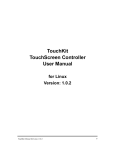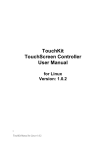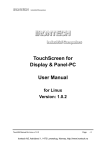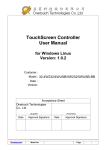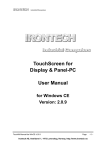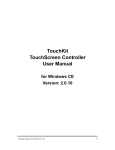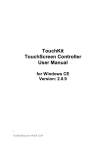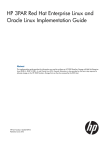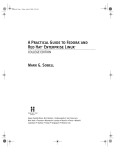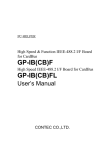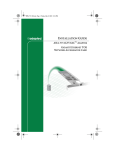Download TouchKit Touch Panel User manual for Linux Version: 3.1.4
Transcript
TouchKit Touch Panel User manual for Linux Version: 3.1.4 TouchKit Touch Panel v3.1.4 0 CONTENT: CHAPTER 1. TOUCH PANEL CONTROLLER......................................................... 2 1.1 CONTROLLER ......................................................................................................................... 2 1.2 SPECIFICATIONS AND FEATURES ............................................................................................ 3 CHAPTER 2. INSTALLING AND USING TOUCHKIT .............................................. 5 CHAPTER 3. CONFIGURATION UTILITY AND RIGHT BUTTON EMULATOR.....10 CHAPTER 4. UNINSTALLING TOUCHKIT .............................................................15 TouchKit Touch Panel v3.1.4 1 Chapter 1. Touch Panel Controller This touch panel controller provides the optimistic performance of analog resistive touch panels for 4 wire, 5 wire and 8 wire models. It communicates with PC system directly through RS232, PS/2 or USB connector. User can see how superior the design is in sensitivity, accuracy and friendly operation. The touch panel driver emulates mouse left and right button function and supports operation systems including Microsoft Windows 95/98/ME/2000/NT/XP/XP Tablet PC Edition, Windows CE 2.12/3.0/. NET, Linux, iMac and DOS. 1.1 Controller Interface RS232 USB PS/2 4-wire 5-wire 8-wire Ready Ready Ready Ready Ready Ready Ready Ready Ready TouchKit Touch Panel v3.1.4 2 1.2 Specifications and Features Specifications for Touchkit controller. Specifications Power requirements Operating temperature Storage Temperature Relative Humidity Protocol Resolution Report rate Response time Pin out definition Panel resistance Regulatory Approvals TouchKit Touch Panel v3.1.4 +5VDC ( Maximum 100mA, typical 70mA, 50mV peak to peak maximum ripple ) 0 to 50 ℃ -40 to 80 ℃ 95% at 60 ℃ RS232 Model: 9600 bauds, None parity, 8 data bits, 1 stop bit USB Model: USB 1.1 Low speed PS/2 Model: PS/2 mouse 2048 X 2048 RS232 Model: Max. 160 points/sec USB Model: Max. 160 points/sec PS/2 Model: Max. 140 points/sec Resistive: Max. 35 ms Capacitive: Max. 20 ms 4 wire model: X, Y, X, Y 5 wire model: UL, UR, COM, LR, LL 8 wire model: X+, X+ref, Y+, Y+ref, X- , X-ref, Y-, Y-ref 4, 8 wire resistive model: 200 ~ 900 ohm ( pin to pin on the same layer ) 5 wire resistive model: 50 ~ 200 ohm ( pin to pin on drive layer ) FCC-B, CE 3 Features for Touchkit software Features Calibration Compensation Draw Test Controller Setting Language Mouse Emulator Sound Notification Double Click OS support COM port support TouchKit Touch Panel v3.1.4 1. Fast full oriental 4 points position 2. Support monitor / display rotation 3. Support multiple monitor / display 4. Support QVGA and Half-VGA function Accuracy 25 points linearity compensation. Position and linearity verification 1. Support multiple controllers 2. Dynamical add / remove controllers 3. Change Controller interface without reboot. Support 9 languages for Windows 1. Right / Left button emulation 2. Normal / Click on touch / Click on release mode 3. Cursor visibility 1. No sound 2. Touch Down 3. Lift Up 4. Frequency adjustment 5. Duration adjustment 1. Configurable double click speed 2. Configurable double click area 1. Windows 95/98/ME/NT4/2000/XP/ Windows XP Tablet PC Edition 2. Windows CE 2.12, 3.0, .NET 3. Linux ( X Window Version: 3, 4 Red Hat 6.0 ~ 8.0 Mandrake 5.0 ~ 9.0 ) 4. iMac. OS9 5. MS-DOS: Support display resolution: 320x200, 640x200, 640x350, 640x480, 800x600, 1024x768 and 1280x1024 1. Support COM 1 ~ COM 256 for Windows and Linux 2. Support COM 1 ~ COM 8 for DOS 4 Chapter 2. Installing and using TouchKit Tested distributions: z z z z z z z z z Red Hat 7.0 kernel version 2.2.16, Red Hat 7.1 kernel version 2.4.2, Red Hat 7.2 kernel version 2.4.7, Red Hat 7.3 kernel version 2.4.18-3, Red Hat 8.0 kernel version 2.4.18-14, Mandrake 8.0 kernel version 2.4.5 Mandrake 8.1 kernel version 2.4.8 Mandrake 8.2 kernel version 2.4.18 Mandrake 9.0 kernel version 2.4.19 TouchKit is software, which contains drivers and two utilities of the touch panel controllers for RS232, PS/2 and USB on Linux operation system. The two utilities are as follows: • Configuration support The calibration and draw test of touch panel are done by this utility. • Right button support This is utility for emulating the right and left button of mouse through controlling touch panel. User can toggle between right or left mouse buttons by this utility. We provide two way to install the driver, one is automatic installation and the other is install manually. <Automatic Installation> Before install TouchKit for Linux, please make sure that (1) user have root privilege and that (2) X window system has been configured correctly. Follow these steps to install TouchKit for Linux. 1. Put the TouchKit CD to CD-ROM and mount it on Linux operation system. e.g. with command: mount /dev/cdrom /mnt/cdrom 2. Change directory to /mnt/cdrom/Linux/Other Version TouchKit Touch Panel v3.1.4 5 3. Execute script touchkit.setup.sh with command sh touchkit.setup.sh 4. The script will extract files to temporary directory and start installing: (*) Extract files from [touchkit.setup.sh] to [/tmp/touchkit] (*) Start installer [/tmp/touchkit/setup] === TouchKit for Linux Installer === (Step 1) Check Packages Installed [Common] make OK (make-3.79.1-5) tcl OK (tcl-8.3.1-46) tk OK (tk-8.3.1-46) [Required for Full Mode] gcc OK (gcc-2.96-54) glibc-devel OK (glibc-devel-2.1.92-14) XFree86-devel OK (XFree86-devel-4.0.1-1) kernel-source OK (kernel-source-2.2.16-22) The first step is to check if software configuration is ready to install and to utilize TouchKit. Installation will abort if some Common packages are missing; please reinstall TouchKit after all those packages being installed. 5. Press [1] or [2] followed by enter to select installation mode depending on the communication interface of TouchKit controller. (Step 2) Select Installation Mode (Q) Which installation mode do you prefer? (1) Compact Mode, (only RS232 and PS/2) or (2) Full Mode (RS232, PS/2 and [USB]) 6. If Full Mode is selected, installer starts building process. TouchKit Touch Panel v3.1.4 6 1 (I) [Full Mode] selected (Step 3) Rebuild TouchKit for n in include driver utility xf86drv diag usb; do make -C $n || exit 1; \ done . . . : '+-----------------------------------+' : '| Build-All Complete Successfully |' : '+-----------------------------------+' \ 7. After building process completes successfully (or if Compact Mode is selected), TouchKit will be installed into system; user must restart X window system to see the change. (Step 4) Install TouchKit (*) Install USB module [/lib/modules/2.2.16-22/usb/tkusb.o] (*) Install touch panel daemon [/usr/bin/tpaneld] (*) Install configuration utility [/usr/bin/touchcfg] (*) Install XFree86 driver [/usr/X11R6/lib/modules/input/touchkit_drv (*) Generate uninstall script [/usr/bin/uninstall_TouchKit] (*) Update system starting up script [/etc/rc.d/rc.local] (*) Update XFree86 configuration [/etc/X11/XF86Config-4] +--------------------------------------+ | Installation Complete Successfully | +--------------------------------------+ (I) Start TouchKit touch panel daemon (I) Start USB module (I) Please RESTART your X Window Server. 8. To install driver for Redhat 8.0, Redhat 9.0, please repeat the step 1~ 6 as the same as other version of Linux. The difference between Redhat 8.0/9.0 and other version is the install directory changed to /mnt/cdrom/Linux/Redhat8. Execute script touchkit.setupr8.sh with command sh touchkit.setupr8.sh. Two of software packages should be installed first, since they are not for default installation when installing OS. (1) sharutils-XXX.rpm (2) XF86Free-develXXX.rpm User can find these packages in disc3 and disc2 in RedhatLinux 8.0 distribution. TouchKit Touch Panel v3.1.4 7 Also, user can find these packages in this touchkit driver Redhat8.0 subfolder. < Manual Installation > The following manual installation is only for X Window V 4 1. Please unzip Touchkit.tgz to /usr/local/TouchKit 2. copy tpaneld to /usr/bin 3. copy touchkit_drv.o to /usr/X11R6/lib/modules/input 4. copy tpaneld.conf to /etc Please confirm the contain is as follow: tpaneld.conf MouseMode = DRAWING DblClickSpeed = 18 DblClickArea = 30 RClickTool = 0 Sound = 0 Port = /dev/ttyS0 Port = /dev/ttyS1 Port = /dev/psaux Port = /dev/usb/tkpanel0 Port = /dev/usb/tkpanel1 Note: the setting of ports depends on the outcome of system scanning, but users could amend the port by themselves. 1. Please review /etc/rc.d/rc.local, and make sure that the following sentences are added. ## TouchKit section begin ( Please do NOT edit this section!! ) ## /usr/bin/usbpnpd /usr/bin/tpaneld ## TouchKit section end # TouchKit Touch Panel v3.1.4 8 2. Please review the XF86Config file for X Window a.) For Red hat Linux : Please review /etc/X11/XF86Config and make sure that the following sentences are added. ## TouchKit section begin ( Please do NOT edit this section!! ) ## Section "InputDevice" Identifier "TKPANEL" Driver "touchkit" Option "Device" "/dev/tkdat0" Option "DebugLevel" "0" EndSection ## TouchKit section end ## b.) For Other Linux distribution: b-1) XFree86 V4.x Edit the file /etc/X11/XF86Config-4 and make sure that the following sentences are added. ## TouchKit section begin ( Please do NOT edit this section!! ) ## Section "InputDevice" Identifier "TKPANEL" Driver "touchkit" Option "Device" "/dev/tkdat0" Option "DebugLevel" "0" EndSection ## TouchKit section end ## b-2) XFree86 V3.x Edit the file /etc/X11/XF86Config and make sure that the following sentences are added. ## TouchKit section begin (Please do NOT edit this section!!) ## Section "Module" Load "xf86TouchKit.so" EndSection TouchKit Touch Panel v3.1.4 9 Section "Xinput" SubSection "touchkitpanel" Port "/dev/tkdat0" DeviceName "tpanel" AlwaysCore DebugLevel 0 EndSubSection EndSection ## TouchKit section end ## 7. Restart X Window. 8. /usr/local/TouchKit/diag contains the following files: 4pcal 4points calibration ex. 4pcal /dev/ttys0 25pcal 25 points calibration ex. 25pcal /dev/ttys0 drawtest drawing test ex. drawtest /dev/ttys0 TouchKit Touch Panel v3.1.4 10 Chapter 3. Configuration Utility and Right Button Emulator The touch-sensitive area of the panel and touch-sensitivity both can be modulated through the configuration utility. Besides, the controller identification and device activated shall be done first. After installation TouchKit, execute touchcfg to start the configuration utility. The Panel Candidate List, which contains by default two RS232, one PS/2 and two USB devices, commands TouchKit driver which port to probe for controller. If a port is occupied by other device, e.g. /dev/ttyS1(COM2) is used by a mouse, it is recommended to Remove /dev/ttyS1 from the list, since the probe process would interfere the operation of mouse. If the user need another com port, for example com3, please go to /etc/tpaneld.conf and add the sentence Port = /dev/ttyS2. < tpaneld.conf > MouseMode = DRAWING DblClickSpeed = 18 DblClickArea = 30 RClickTool = 0 Sound = 0 Port = /dev/ttyS0 Port = /dev/ttyS1 Port = /dev/psaux Port = /dev/usb/tkpanel0 TouchKit Touch Panel v3.1.4 Port = /dev/ttyS2 is added to use com3 Port = /dev/ttyS3 is added to use com4 11 Port = /dev/usb/tkpanel1 After checking that touch panel devices (included its controller) are equipped well, user may click [Rescan] button to scan all devices listed. If there are any additional connections excluding default connections, please press [Add] button to set specific settings. Select one device after import more than one device at the panel list window. The one selected will activate the panel. The Sound option provides user the click feedback while the click actions are done. There are five buttons, [Draw Test], [4-PT Cal], [Advanced], [About] and [Close], at the lower section of the TouchCfg window. <DRAW TEST> Test the drawing position related to the display screen on panel. Click on the [Draw Test] button. There will be a squared blue display showing. Try to write or draw on it to verify the touch position. Press <ESC> to exit. TouchKit Touch Panel v3.1.4 12 <4-PT Cal> Correct 4 point locations on screen with the panel. Press [4-PT Cal], screen displays as follows. Touch the blinking symbol on panel until beep or stop blinking. <Advanced> Press [Clear] to clear the previous calibration records. The record will become default record. TouchKit Touch Panel v3.1.4 13 Press [Calibrate] to execute 25 points calibration. Correct 25 point locations on screen with the panel. Touch the blinking symbol on panel until beep or stop blinking. There will be a message window after this correction. After the calibration, the new record will overwrite the old one. <Mode Button> Check it or not to turn mouse button, which provides mode selection and right button emulation, on or off. Change right / left button by click the button shown on the right-bottom corner of screen. Blue area expresses what button has been selected. After select the button, user can touch the panel to control mouse activities. Select / De-select files or Drag icons on screen, whatever the mouse behaves. <Double Click Speed> Double Click Speed is the time of the touch panel response when someone double click it. Drag the cursor from left to right is slow to fast. <Double Click Area> Each one touch has its own touch tolerance once someone may not fix in one point. So if user sets the Double Click Area to <Smaller>, the panel will be very sensitive about micro-move while user wants to fix on a point. If user sets it to TouchKit Touch Panel v3.1.4 14 <Larger>, it tolerates the larger touch point movement while user wants to point at a fixed position. <About> Information about TouchKit. <Close> Close TouchKit touch panel utility. TouchKit Touch Panel v3.1.4 15 Chapter 4. Uninstalling TouchKit To uninstall TouchKit all user has to do is execute uninstall_TouchKit in text mode. TouchKit Touch Panel v3.1.4 16

















